Terra Advena - Dragonborn
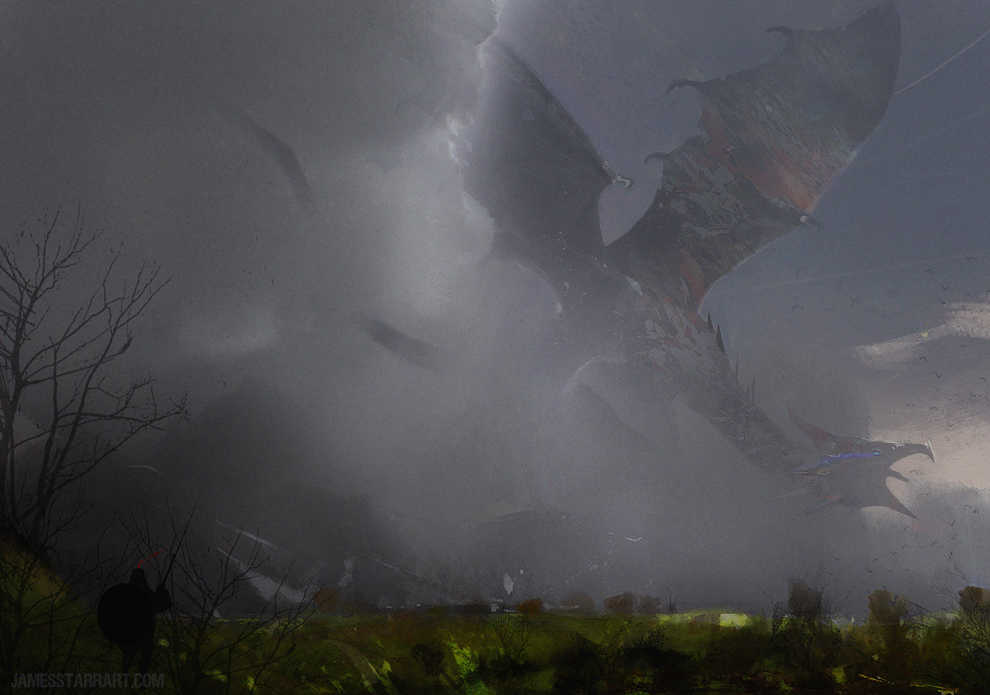
The history of the dragonborn - iladeim, in their tongue - is one of extreme strife coupled with great pride in their role as the literal children of the gods... for that is exactly what they believe their draconic parents (or grandparents, great-grandparents, and so on) to be. And if one judges by the powers the dragonborn gain from their faith, they may not actually be wrong.
By the common calendar used by the Imperium, dragons arrived announced by a storm of elemental fury that lasted for months, in the year -63 IC. Records of the time are scattered and patchy, and the best belong to the gargoyles who remained awake, but those are often long buried. Still, the records one can find tell of great winged lizards, dozens of feet long with wings that "blot out the stars" descending from the skies in waves along most of the eastern coasts of Advena. They arrived carrying dozens of twisted, stunted humanoids they called kobolds, who had long been their servitors.
When the dragons arrived, they drove gnolls away from the lands they immediately claimed their own, pushing the unprepared creatures who had only ever fought amongst themselves from the life-giving flood basins and great fertile valleys of eastern Advena. But the dragons did not pursue - instead, they settled, claiming swathes of land a league square as their private domains, using their natural control over the elements and the hands of their kobold servants to carve homes for themselves in this new land. Perhaps things would have continued apace, except the dragons were not unchanged by their arrival upon Advena.
The First Dragonborn
The first inklings the dragons had were when the broods of unfertilized eggs they laid shortly after arriving - intended to hatch into a new wave of kobold servants - lay, unhatched, for months beyond what they should, but still pulsed with life and the arcane energies of the dragon's elemental power. When they finally hatched, nearly a year overdue, each egg of the dozens laid by each dragon spilled forth creatures far more majestic than any kobold, humanoids bearing the shape and structure of their parents. The iladeim, true children of the dragons.
Within a few years, the iladeim had grown tall and strong, each easily towering nearly twice the height of their kobold kin that had, always before, hatched from unfertilized dragon eggs. And unlike the kobolds, pale, grey, twisted creatures weak of arm and clever of mind, these dragonborn were strong, hardy, and their coloration echoed that of the dragons themselves. More than that, they contained within them some portion of the elemental power the dragons knew as their birthright, each iladeim able to exhale a burst of pure elemental energy of one form or other. The dragons were delighted with these new, far superior, servants, and set about creating more in huge numbers.
Within half a century, the dragons had birthed hundreds of such children each, their development accelerated so that each reached physical maturity within but a handful of years. And with these halfblood children, the dragons determined that they must control the rest of Advena, so as to give them room to grow and develop further. And thus began the first dragon-gnoll war.
Advena had never before seen such a conflict. Prior to now, battles had been limited primarily to various gnoll tribes feuding with one another, or phyton raiders from the Vwoduhi gathering supplies from nearby communities. This, however, was war. Great dragons, each easily a match for scores of warriors, each led dozens of dragonborn westward into the heart of Advena. At first, they encountered no resistance - tribe after tribe, used to caring for their needs on their own, were no match for the even tenuous order of an organized army. The ursine kingdom, greatest of the gnoll civilizations, fell in the second year.
All was not lost, however. In the third year, a charismatic leonine gnoll united first dozens, then scores, then hundreds of gnoll tribes under a single banner, and they began pushing the dragons and their children eastward. The dragons were mighty, but they could be slain, and their dragonborn children were too few to hold against a sustained counter-offensive. After three years, the war ended with the gnolls pushing the dragons back eastward past the {river name}, reclaiming large swathes of central Advena.
Recovery and Formation of Bein-Zoltak
This loss was devastating to the relationship between the dragons and their children, who no longer viewed them as flawless god-beings. And so, in the callous manners of a creature who knows itself to be the center of the universe, the dragons drove their children to the southeastern wastes of Advena, punishment for a failure they could never have been responsible for. With the witnesses to their loss gone, the dragons set out to birthing a new generation - and then another, and then another. In nearly fifty years, the dragons, laying eggs at a prodigious rate, spawned incredible numbers of new children, raised to never know of their previous failure, and in 42 IC, they launched another attack at the gnolls.
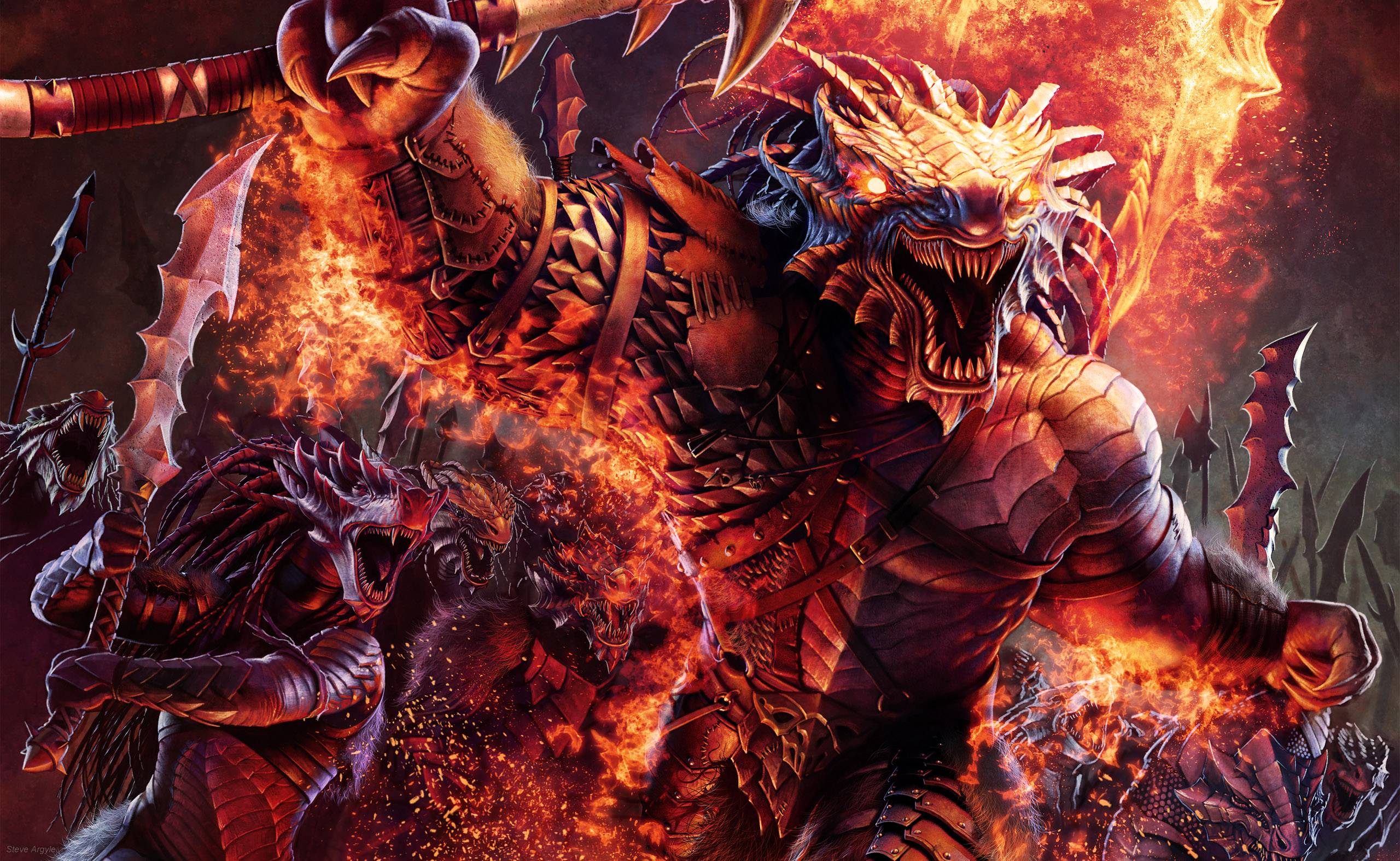
The dragons were prepared this time, and when they went to war, their children filled the horizon as far as the eye could see. But the gnolls had not been idle, and the new Imperium was prepared for the attack they knew would come. Battle raged for over a decade, the elemental behemoths that were the dragons, bolstered by millions of supporting iladeim, pitting their might against the tooth and claw and shamanistic arts powered by willing blood sacrifices from those who were too old to fight, and neither could gain enough of an upper hand to end the war. In 57 IC, however, the gnolls made alliance with the dwarves of Chaeloth, who had also suffered losses at the hands of the dragons and their children, and together the two were able to force the end of the conflict - an end that resulted, for the first time, in gnoll and dragon sitting across from one another for peace talks. The dragons gained lands into the heart of Advena, but no further than the edges of the {forest name}, and the gnolls were left with the great plains of the southwest and the swamps below.
Forced to lick their wounds once again, the dragons had learned by now that their children were able to reproduce amongst themselves - a development that would allow them to continue developing without the direct hand of their parents. Unwilling to allow control to slip away, dragons settled into the role of local lords, each ruling a private demesne composed of hundreds or thousands of iladeim. During this time, their servants built great palaces and cities scaled such that the dragons could easily move around them, often open to the sky in places to allow flight. The dragons gifted their children with great knowledge, the ageless wyrms teaching them architecture and arcana, literacy and mathematics. The iladeim grew as a people, and a society.
By the second century IC, a stable system of rule had developed in the lands that were now known as Bein-Zoltak, land of the five elements. Each dragon was sole master of their demesne, and sat in a council that met every other year in the capital city. The dragons then chose one from every dozen of their own to speak for them, as they waged battles of politics, trading favours, goods, and servants in a complex web of diplomacy and deceit. The iladeim, meanwhile, obeyed and learned.
Trials and Loss
In 320 IC, however, the Council met to discuss a grave matter. Since arriving in Advena, no dragon had given birth to true children - another dragon. This was of no concern in their first century, as the dragons had been too busy intentionally birthing more servants, and the same continued for most of the second and third centuries. But after a hundred and fifty years of relative peace, when they no longer needed to provide a stable breeding pool of the iladeim, some had began coupling together and laying fertilized eggs, for the first time in centuries. And the eggs lay, lifeless and cold, hatching neither dragon nor dragonborn.
For decades, the dragons sought answers. They believed that, perhaps, whatever arcane energies that permeated Advena and resulted in the birthing of dragonborn instead of kobolds had, in fact, also prevented them from giving life to new dragons. Searching for concentrations of arcane power, the dragons recognized the sites of various gargoyle settlements, scattered through both the modern Imperium and the far western continent, beyond the sea. Desperate to access these sites, and unwilling to beg entrance from their scaleless foes, the third dragon-gnoll war began in 367 IC.
Once again, however, the dragons were met by a prepared force, the Imperium turning their naturally combative natures into preparation for the war they knew was inevitable - and the iladeim, in contrast, had become bureaucrats, scholars, engineers, and great builders, not consumate warriors. The dragons, as well, did not fight as savagely nor with as much a sense of their own immortality, having been taught during the second war that they could be slain, and knowing that, without true children, they could not replenish their numbers. Within a decade, the war slowed to a halt, though no formal truce was ever declared.
Unable to reach the sites of energy within the Imperium, and unable to find or decipher the information they found in ruins beyond the Coranth, the dragons faced a grave dillema - though ageless, most of their number felt an undeniable urge to create true offspring every half-millenia, an urge biological and one they were incapable of fighting. And unable to conceive while they lived upon Advena, in 514 IC, the dragons left the world in the same manner they had arrived - each bearing a dozen or more servants upon their back as they fled into the space between worlds to seek another, more hospitable home.
Abandoned
Unsurprisingly, this event had drastic effects on dragonborn society. While they had come to know the dragons as fallible over the centuries, and few of the iladeim were still direct children of a dragon, they still viewed them as both their parents and leaders, respected for their great power and knowledge. Many of the demesnes were unable to function without a dragon managing their affairs, used to a lifestyle where they specialized in a specific manner of good or crop that was traded away with other demesnes, sometimes hundreds of leagues away... a daunting trip on foot, but an incredibly manageable one for a great dragon.
Some demesnes collapsed into anarchy or despair, but others, led by either those with great faith or will, or whose masters had been unusually lax and allowed their servants to handle most of their affairs, began to wrangle order from this chaos. The dragons, some claimed, were testing their children, watching to see if they had yet become adults who no longer required supervision. Others countered with the idea that they owed the dragons nothing further, and as they were on their own, they should shape their own destiny. Eventually, the system stabilized into one where each demesne was still ruled by a single individual, the head of a family (generally that which was closest to the dragon master of times past) managing the affairs and acting as lord. In turn, they continued the draconic practice of convening in a senate to discuss matters which affected them all.
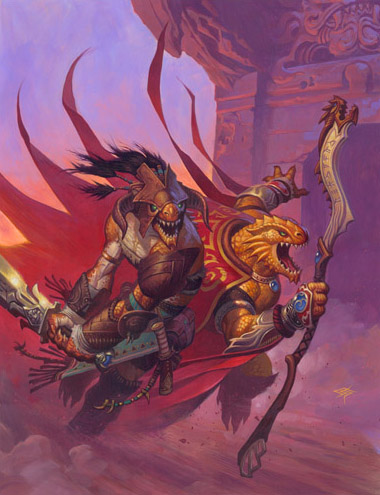
Centuries passed, with the iladeim growing as a people and a society and then falling into internecine struggles as demesne matched demesne in battles of commerce, religion, and culture. Alliances rose and fell, factions within the senate controlling the direction of Bein-Zoltak for a decade or three, then falling into disfavour as another faction rose to prominence. In 657 IC, the fourth - and to date, final - dragon-gnoll war began (or, perhaps more accurately, the third war roared back to life), fueled by disputes over border territories. Their skills at battle sharpened through internal conflict, and the iladeim mages wielding vast magical powers unseen on Advena since the days of the gargoyles, this war was a closer one, and waged for 34 years, when the two great nations once again met on the peace table, overseen by neutral dwarves, to sign the treaty that established their borders as they are now known.
Perhaps things might have changed, but for the arrival of a great plague, the Ravaging, in 782 IC. Sweeping through the Imperium and turning many of their people into brutal monsters, the iladeim were at first concerned, and then enthralled as they watched their ancient enemies fall to their own people. But when the Imperium, with the strength of their shamans, erected the last of their great menhir in 807 IC, forming a psychic barrier the feral orques couldn't cross, amusement turned to fear - with nowhere else to turn, the afflicted ravaged the western borders of Bein-Zoltak, the already great gnoll strength driven to incredible levels by this plague. Over four years, the dragonborn saw nearly a third of their civilization swallowed in flames, fur, and blood, but in 786 IC their armies, mustered from the northern and eastern demesnes and supported by the greatest magisters, met the orques in the Battle of the Endless Dead.
At the end of the battle, which raged for five days and nights, nearly three million corpses dotted the field, but the iladeim were victorious, the brutal orques finally breaking and falling back into the woods and the mountains between the edges of Bein-Zoltak and the mystically enforced borders of the Imperium. The very next spring the senate authorized the construction of a great wall across the edge of Bein-Zoltak, the only measure ever to pass with no dissent. It took over fifty years to complete the project, but when it was, the wall spanned over 400 leagues, ending in the highest peaks of eastern Chaeloth.
Modern Bein-Zoltak
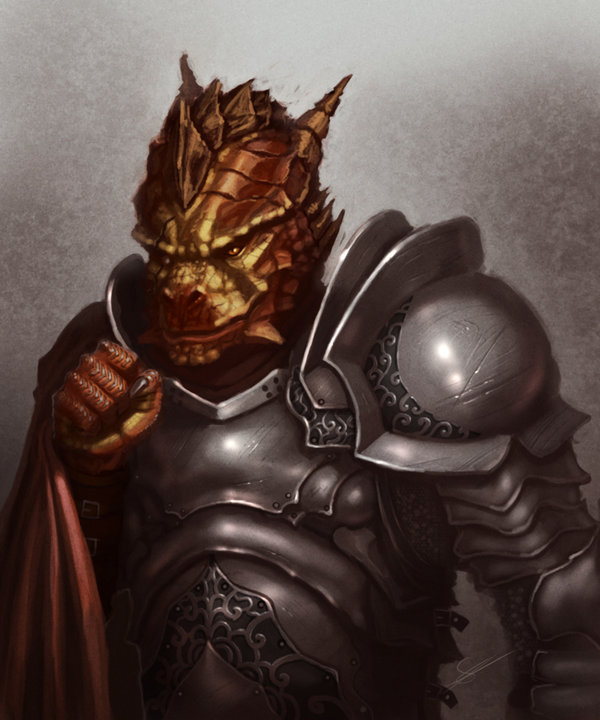
Still a nation of scholars, engineers, and merchants, the iladeim are also skilled warriors - because with their neighbours, they have to be. All families are required to send at least two of every three children to the Wall, where they spend at least four years serving, and many serve significantly longer. In addition to serving as warriors, over the centuries, various sections have been built up, as construction is considered a great method of keeping young warriors out of trouble. Because of this, sections of the wall reach nearly 75 feet in height, and they are generally at least 50 feet in width, with barracks, mess halls, and armories built directly upon and inside the Wall itself.
However, not all has been peaceful. Northern demesnes, far from the front lines and never assaulted directly by the orques, often resent the tithes all are required to pay towards the maintenance of such a structure, and twice in the last five centuries, they have rebelled, once cutting off all trade with the southern demesnes, and once in actual armed combat, in 1097 IC. Said rebellion actually resulted in the first true breach of the Wall since its construction, and the razing of a half-dozen demesnes along the border before various concessions to the northern demesnes ended the civil war and returned soldiers to the field.
Physical Description
The average iladeim stands about six foot, and generally weighs about 200 pounds - they are slightly heavier than might be normal for their size due to their heavy layer of scales weighing more than an equivalent amount of hair or pale flesh as an outer cover. Their heads are generally longer than they are tall, but take many different shapes - some come to a rather pointed 'beak' shape while others are square and blocky, and a third may be broad and crested. They have three toes on each foot, and they put most of their weight to the front of each foot rather than the heel.

Dragonborn coloration tends towards being a single solid color, in any of dozens of different hues, though shades of red, green, and bronze are the most common. Contrary to popular belief, the color of an individual's scales has no bearing on their elemental breath, nor is it generally a sign of any particular stature.
Most notable features - especially those that vary from iladeim to iladeim - include tails, wings, and horns. The most common of these features is horns, but they are at most no more common than those without. Dragonborn horns come in many shapes and sizes, from singular horns located out of the center of one's snout, or paired horns jutting from the sides or foreheads. In any case, many horned dragonborn learn to use these natural weapons as well as their breath or a gnoll might their claws. Similarly, but rarer, perhaps a third of all iladeim retain their tail for longer than the first few weeks post-birth, growing as they do. Those blessed with such an extremity find that it serves as both a useful tool for balancing and an additional weapon while in need.
Finally, the rarest of all mutations amongst the iladeim - though records show that it was once more common amongst those birthed from dragon eggs as opposed to borne naturally by another of their own species - are wings. Eight to ten foot spans of leather and bone, they protrude from the upper back and, if nothing else, are a majestic sight. Even the lightest of dragonborn are unable to use their wings for true flight - whatever their enormous progenitors used to fly despite their size is unknown - but they do find them of great use in gliding and ocasionally combat.
Elemental Manifestation
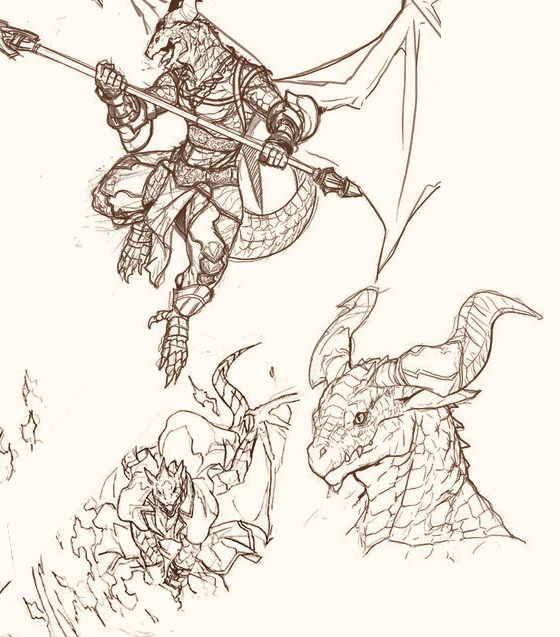
The most unique feature of the dragonborn, however, is their connection to the same primal elements that their draconic forebearers held. While the iladeim ability to exhale clouds of energy is weaker, it is hardly less impressive. Scholars have suggested that the ability comes from some sort of unusual organ in the lower throat or gastrointestinal region, but when the occasion has been available, no such thing was found during any form of disection. The iladeim generally accept that their deadly breath has no natural origin, and cherish it as a great gift.
The most common breath weapon is, perhaps unsurprisingly, fire. Fully half of the iladeim are capable of exhaling gouts of searing heat and flame. Crackling lightning and chilling cold are less frequent, but certainly compete for second place, and far behind them are caustic or toxic clouds of gas. Least common of the exhalations is a booming surge of force and sound. Oddly, one's parentage appears to have no bearing on the form their breath takes.
Perhaps one in every ten iladeim prove incapable of commanding the elements in this fashion. For some time, they were held to be despised mutations, and forbidden to breed (and, in some demesnes, killed). However, in the wake of the Ravaging, the scholar Farzin Niloofar discovered that, with the proper mental stimulus, these invalid dragonborn were instead capable of projecting an aura of abject terror for a short time - terror capable even of penetrating the fearless minds of the orques. Since her time, dragonborn able to harness the power of draconic presence, as it has become known, have become valued members of the nation, especially upon the Wall.
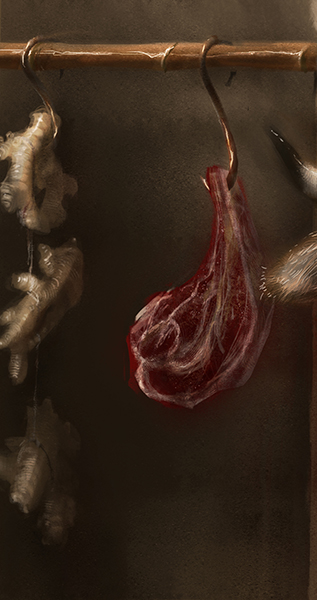
Diet and Other Notes
Dragonborn are omnivores, capable and generally willing to eat just about anything someone might call "food" - though they're generally pickier than the nearby gnolls, unwilling to eat things that have begun to sour or rot. Iladeim cuisine is generally heavily spiced, and many often joke that it is to keep the fire in their bellies hot. Milk is only drank by children, as most adult dragonborn find that it turns their stomache. Instead, they generally prefer spiced ciders and wines.
Staples of their diet include dont- and lizard-meat, as well as large amounts of corn, soybeans, and various types of peas. Merchants in Bein-Zoltak can often be found selling barely-cooked meat on a stick - perfect for a fire-breathing dragonborn to sear to exactly his or her preference, or, if they are unable, most carry several well-grilled, as well. Despite their presence in Bein-Zoltak, iladeim rarely make meals of catoblepas meat - the dangerous beast of burden gives up meat that, while perhaps not poisonous, is generally unpalateable to all but those dragonborn who find themselves connected to either toxic gas.
The herb shan'belaih bears special mention. While never proven, many dragonborn swear that making it a regular part of one's diet strengthens their breath weapon. Because of this, it is commonly available within Bein-Zoltak as a supplement, though rarely eaten as part of a meal, as it has an extremely bitter flavor.
Religion
Dragonborn religion is dualistic. Fundamentally, they revere the dragons who gave them life. Borrowing from their ancestor's faith, they worship Bahamut and Tiamat, the twin creators of dragonkind. Bahamut is praised for his commitment to order and justice, duty and proficiency, and generally seen as the root of civilization and the center of the family. Tiamat, conversely, is the goddess of chaos and freedom, change and creativity, and is the patron of the arts, the underclass, and love.
In addition to these two primal deities, many of the iladeim also worship the dragon that began their family, or that of the demesne that they call home, often considering them to be a sort of go-between between the dragonborn and the twin gods. These local deities have vastly different realms of influence and commands, so the focus of the religious calling of a dragonborn from the Ashad-Ul province may be rather different that one from Sahe-Laa-Tinuo - but it is important to note that few dragonborn would ever put the demands of their personal deity above the strictures and demands of the two progenitors.
Miracles
Sometime, I'll write up something about prismatic dragonborn here. But it is not this day!
Mechanics
Dragonborn characters from divine classes may select any domains - there is enough variation between different patrons that any belief set is reasonably possible. Do note that I'm going to get on your case if you pick, for instance, poison, healing, torture, and civilization - you'll need a darn good explanation for that set of beliefs.
Terra Advena Dragonborn Mechanical Notes
The dragonborn of Terra Advena are culturally distinct, and several feats are available to highlight those distinctions.
Dragonborn Feats
Battle-Ready Horns
Your horns are particularly large, and you can use them in combat as an additional weapon.
Prerequisite: Dragonborn
Benefit: You can use your horns as a weapon, and are always considered to be wielding them, even when your hands are full. They are considered to be part of the light blade group, have a +2 proficiency bonus to attacks, deal 1d4 damage and have the high crit property. In addition, you gain the goring horns power.
Goring Horns
Feature
You follow up an attack by slamming your horns into your foe, throwing them off balance.
Encounter
Free Action
Melee 1
Requirement: You must have hit with an attack.
Target: One creature you just hit
Attack: Strength vs Reflex, Constitution vs Reflex, or Dexterity vs. Reflex
Hit: Strength modifier, Constitution modifier, or Dexterity modifier damage, and the target is unbalanced.
Dragonborn Spear Training
The dragonborn of Bein-Zoltak prefer spears and polearms, the weapons of the phalanx.
Prerequisite: Dragonborn
Benefit: You gain proficiency with simple and military spears and polearms and gain a +2 feat bonus to damage rolls with such weapons. This bonus increases to +3 at 11th level and +4 at 21st level.
Elemental Shield
Your connection to the elements is strong, and you are able to resist some of the force you yourself can breath.
Prerequisite: Dragonborn, dragon breath racial power
Benefit: You gain resist 5 + one half your level to the damage type of your dragon breath racial power.
Supporting Wings
You have great wings that cannot carry your full weight, but still allow you to glide on the air currents for great distances.
Prerequisite: Dragonborn or gargoyle
Benefit: You gain a glide (clumsy) speed equal to your base speed. In addition, you gain the powerful leap power. If you already have a glide speed, it loses the clumsy descriptor.
Powerful Leap
Feature
You crouch, then let your powerful legs hurl you into the air and spread your wings.
Encounter
Minor Action
Personal
Effect: You fly two squares, and begin gliding.
Weighted Tail
Your tail is large, and provides you with both increased balance and an unexpected weapon.
Prerequisite: Dragonborn
Benefit: You can reroll acrobatics checks to balance and athletics checks to swim. In addition, you gain the Tail Lash power.
Tail Lash
Feature
When pressed, you swing your tail in a wide arc, creating some breathing room.
Encounter
Minor Action
Close burst 1
Target: Each creature in burst
Attack: Strength vs Fortitude, Constitution vs Fortitude, or Dexterity vs. Fortitude
Hit: You push the target 1 square.
Effect: You don't grant combat advantage from being flanked until the end of your next turn.
Wing Fighter
You've learned to use your wings to protect you in combat, batting away attacks before they can always reach you.
Prerequisite: Dragonborn, Supporting Wings feat
Benefit: Your glide speed loses the clumsy descriptor, if it has it. In addition, you gain the Wing Buffet power.
Wing Buffet
Feature
Dust and debris fly as you snap your wings back and forth, protecting you from attacks and throwing your enemies off their guard.
Encounter
Minor Action
Close burst 1
Target: Each creature in burst
Attack: Strength vs Will, Constitution vs Will, or Dexterity vs. Will
Hit: The target grants combat advantage until the end of your next turn.
Effect: You have partial concealment until the end of your next turn.